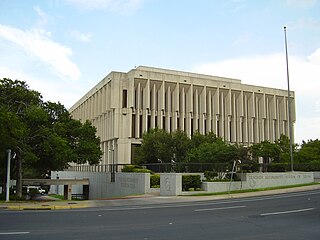
A pension is a fund into which amounts are paid regularly during an individual's working career, and from which periodic payments are made to support the person's retirement from work. A pension may be:
A pension fund, also known as a superannuation fund in some countries, is any program, fund, or scheme which provides retirement income.

The California State University is a public university system in California, and the largest public university system in the United States. It consists of 23 campuses and seven off-campus centers, which together enroll 457,992 students and employ 56,256 faculty and staff members. In California, it is one of the three public higher education systems, along with the University of California and the California Community Colleges systems. The CSU system is officially incorporated as The Trustees of the California State University, and is headquartered in Long Beach, California.

Welfare, or commonly social welfare, is a type of government support intended to ensure that members of a society can meet basic human needs such as food and shelter. Social security may either be synonymous with welfare, or refer specifically to social insurance programs which provide support only to those who have previously contributed, as opposed to social assistance programs which provide support on the basis of need alone. The International Labour Organization defines social security as covering support for those in old age, support for the maintenance of children, medical treatment, parental and sick leave, unemployment and disability benefits, and support for sufferers of occupational injury.

The Employee Retirement Income Security Act of 1974 (ERISA) is a U.S. federal tax and labor law that establishes minimum standards for pension plans in private industry. It contains rules on the federal income tax effects of transactions associated with employee benefit plans. ERISA was enacted to protect the interests of employee benefit plan participants and their beneficiaries by:

The U.S. Railroad Retirement Board (RRB) is an independent agency in the executive branch of the United States government created in 1935 to administer a social insurance program providing retirement benefits to the country's railroad workers.

The California Public Employees' Retirement System (CalPERS) is an agency in the California executive branch that "manages pension and health benefits for more than 1.5 million California public employees, retirees, and their families". In fiscal year 2020–21, CalPERS paid over $27.4 billion in retirement benefits, and over $9.74 billion in health benefits.

Employee benefits and benefits in kind, also called fringe benefits, perquisites, or perks, include various types of non-wage compensation provided to employees in addition to their normal wages or salaries. Instances where an employee exchanges (cash) wages for some other form of benefit is generally referred to as a "salary packaging" or "salary exchange" arrangement. In most countries, most kinds of employee benefits are taxable to at least some degree. Examples of these benefits include: housing furnished or not, with or without free utilities; group insurance ; disability income protection; retirement benefits; daycare; tuition reimbursement; sick leave; vacation ; social security; profit sharing; employer student loan contributions; conveyancing; long service leave; domestic help (servants); and other specialized benefits.

Tricare is a health care program of the United States Department of Defense Military Health System. Tricare provides civilian health benefits for U.S Armed Forces military personnel, military retirees, and their dependents, including some members of the Reserve Component. Tricare is the civilian care component of the Military Health System, although historically it also included health care delivered in military medical treatment facilities.

The California School Employees Association (CSEA) is the largest classified school employees labor union in the United States. CSEA represents a quarter million classified public school employees in California.
In the United States, public sector pensions are offered at the federal, state, and local levels of government. They are available to most, but not all, public sector employees. These employer contributions to these plans typically vest after some period of time, e.g. 5 years of service. These plans may be defined-benefit or defined-contribution pension plans, but the former have been most widely used by public agencies in the U.S. throughout the late twentieth century. Some local governments do not offer defined-benefit pensions but may offer a defined contribution plan. In many states, public employee pension plans are known as Public Employee Retirement Systems (PERS).
Joseph John Jelincic Jr. is an American member of the California Public Employees' Retirement System (CalPERS) Board and is the past president of the California State Employees Association (CSEA), a labor group representing 140,000 active and retired state employees. A rank-and-file investment officer for the CalPERS since 1986, he was elected to the CalPERS Board of Administration in December 2009 as a Member-At-Large representing all CalPERS members.
The California State Teachers' Retirement System (CalSTRS) provides retirement, disability and survivor benefits for California's 965,000 prekindergarten through community college educators and their families. CalSTRS was established by law in 1913 and is part of the State of California's Government Operations Agency. As of September 2020, CalSTRS is the largest teachers' retirement fund in the United States. CalSTRS is also currently the eleventh largest public pension fund in the world. As of October 31, 2020, CalSTRS managed a portfolio worth $254.7 billion.
Contra Costa County Employees' Retirement Association (CCCERA) is a retirement association for Contra Costa County, California's public employees.

Social security is divided by the French government into five branches: illness; old age/retirement; family; work accident; and occupational disease. From an institutional point of view, French social security is made up of diverse organismes. The system is divided into three main Regimes: the General Regime, the Farm Regime, and the Self-employed Regime. In addition there are numerous special regimes dating from prior to the creation of the state system in the mid-to-late 1940s.

Teacher Retirement System of Texas (TRS) is a public pension plan of the State of Texas. Established in 1937, TRS provides retirement and related benefits for those employed by the public schools, colleges, and universities supported by the State of Texas and manages a $180 billion trust fund established to finance member benefits. More than 1.6 million public education and higher education employees and retirees participate in the system. TRS is the largest public retirement system in Texas in both membership and assets and the sixth largest public pension fund in America. The agency is headquartered at 1000 Red River Street in the capital city of Austin.
India operates a complex pension system. There are however three major pillars to the Indian pension system: the solidarity social assistance called the National Social Assistance Programme (NSAP) for the elderly poor, the civil servants pension and the mandatory defined contribution pension programs run by the Employees' Provident Fund Organisation of India for private sector employees and employees of state owned companies, and several voluntary plans.
The Michigan Office of Retirement Services (ORS) administers retirement programs for Michigan's state employees, public school employees, judges, state police, and National Guard. ORS also provides various retiree healthcare benefits, including traditional insurance plans, Personal Healthcare Funds, and Health Reimbursement Accounts. ORS serves over 530,000 customers, representing one out of every fourteen Michigan adults. ORS customers live in approximately one out of every nine Michigan households. The state employee system and the public school employee system administered by ORS make up 95 percent of all active plan membership in Michigan. ORS is responsible for the 18th largest public pension system in the United States and the 47th largest pension system in the world, managing combined net assets of nearly $67.8 billion. In fiscal year 2017, ORS paid out over $7.3 billion in pension and health benefits. According to the Pensionomics 2016 report from the National Institute on Retirement Security, pensions paid to Michigan retirees generated $11.1 billion in total spending in the state of Michigan. A Pew study ranks ORS in the top ten state pension systems for paying the highest percentage of their annual required contribution for pension plans, which demonstrates a commitment to fiscal responsibility. ORS is a division of Michigan's Department of Technology, Management, and Budget (DTMB).
The Los Angeles County Employees Retirement Association (LACERA) is an independent Los Angeles County agency that administers and manages the retirement fund for the County and outside Districts. In 2012, it managed defined benefit pension plans for 156,563 civil servants (members), including 56,752 retirees, making it the largest county retirement system in the United States. In 2018, LACERA's net assets were worth US$55.8billion.
The American Benefits Council (the Council) is a national trade association based in Washington, D.C. that advocates for employer-sponsored benefit plans. The Council's members represent the private employee benefits community and either sponsor directly or provide services to retirement and health benefit plans both nationally and internationally.









